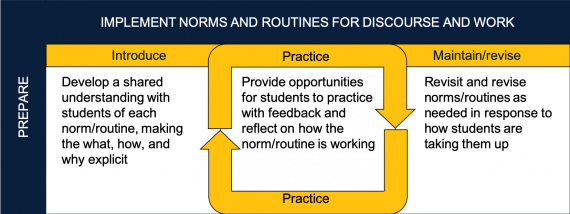Home / Curriculum Resources / Mathematics / Implementing norms and routines for discourse / Overview
What is implementing norms and routines for discourse in mathematics?
Every content area has norms and practices for how people construct and share knowledge. In mathematics these norms and practices include explaining one’s reasoning to others, using mathematical representations to support your explanations, and listening to determine if you are convinced by the reasoning of others to name just a few. Teaching students these norms and practices, showing why they are important, and providing opportunities to use them is crucial for building understanding and capability in mathematics. Teachers name these norms and practices as students use them, provide scaffolds, model, and then offer opportunities for students to use the norms and practices.
Norms and routines for classroom discourse and work are different from organizational routines that are used to manage time, space, materials, and student participation. While these two types of norms and routines are related to one another, norms and routines specific to classroom mathematical discourse and work are focused squarely on supporting students to engage in academic work in ways that are unique to the subject of mathematics. For example, the norm of using mathematical representations to support your explanations is a subject-specific norm critical to discourse and work in mathematics, whereas a system for sharing the responsibilities of recording a solution strategy is an organizational routine often used in mathematics classrooms to support small group work. We use the term “norms” to refer to a widely shared and accepted standard for work in a discipline. Subject-specific norms exist outside of individual classrooms and are often the standards of a discipline. This is not determined by a single teacher in a classroom, but by the broad community of disciplinary experts. It is through routines or practices that a norm is regularly carried out in a particular context and content area.
How can implementing norms and routines for discourse advance justice?
Norms and routines for discourse and work are important for supporting students to engage in content area work. They make explicit for students the ways of thinking and working that are privileged by the disciplines and help position students as competent sense-makers in the content area. However, teachers must recognize when and how norms and routines for discourse and work may marginalize children. Because content area norms and routines often reflect dominant power and privilege, they can marginalize the skills and perspectives some students bring to classrooms. When choosing and implementing norms and routines for discourse and work, teachers should consider carefully which norms and routines to introduce, whom they privilege, and how to teach them.
How do we decompose the practice into learnable parts?
The practice of implementing norms and routines for discourse is broken down into learnable and teachable components, as represented in the decomposition chart below. It is broken into two main areas of work: preparation work and implementation work. Each area of work is further decomposed into discrete moves or techniques that can be examined, practiced, and refined.

Preparation for implementing norms and routines for discourse involves among other things examining the norms and practices central to the discipline of mathematics, understanding the relationships between these disciplinary norms and social and political power, anticipating challenges students may encounter enacting the norms, and prioritizing and sequencing the introduction of norms and routines across the year.
Implementation of a given discourse norm includes introducing the norm, creating opportunities for students to practice the norm, and revisiting the norm to maintain or revise it. Some key elements of these phases of implementation are summarized in the decomposition above.